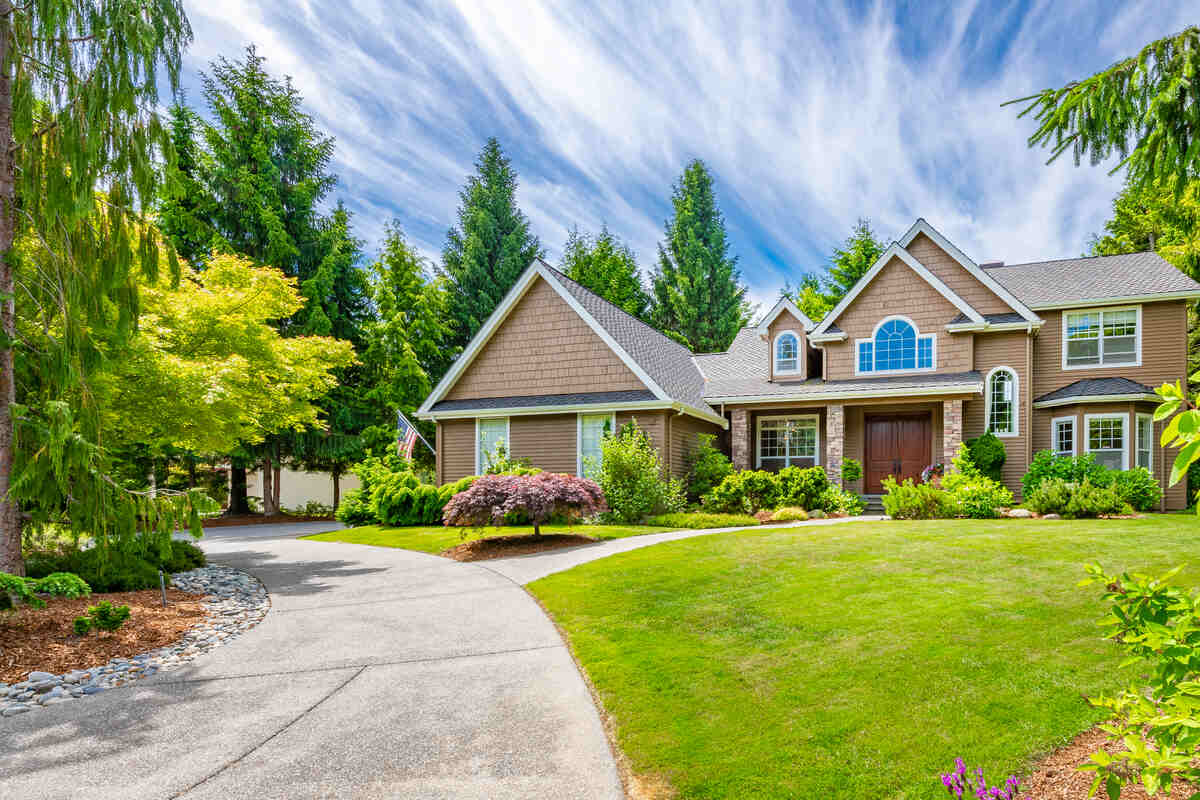
The Pacific Northwest is known for its stunning natural beauty. But if you’re a homeowner, it’s also essential to consider the local climate and geography when choosing grass for your lawn. Whether you live in the coastal region or the eastern part, finding the right grass seed for the Pacific Northwest can make all the difference in achieving a lush, healthy lawn.
This article will explore the different types of grass available for the Pacific Northwest. From the damp coastal areas to the dry eastern plains, we will highlight the most suited option for your lawn. So, whether you’re in Washington, Oregon, or Idaho, get your gardening gloves, and let’s dive in!
If you want a fast overview, check out our summary on how to choose the best grass seed for the Pacific Northwest.
Cool-Season Grasses
Kentucky Bluegrass

Photo Credit: Matt Lavin / Flickr / CC BY-SA 2.0
Kentucky bluegrass is one of the most popular grass seed options in the United States, and the Pacific Northwest is no exception. This durable grass can withstand heavy foot traffic, making it a popular choice for lawns, parks, and sports fields.
One of the key benefits of Kentucky bluegrass is its cold hardiness, making it an excellent option for regions with freezing winters. However, it may struggle in areas with frequent rain, such as western Washington. Still, it can be used in seed mixes rather than as a monostand in this area.
It’s worth noting that Kentucky bluegrass requires a bit more maintenance compared to some other grass varieties. For example, it may require more frequent watering in areas with hotter summers. It also benefits from regular fertilization.
Classification: Cool-season grass
Spreads by: Rhizomes
Shade tolerance: Low
Drought tolerance: Moderate
Foot traffic tolerance: Moderate
Maintenance needs: Moderate mowing frequency and high fertilization needs.
Mowing height: Set mowing height between 2.5 and 3.5 inches.
Potential for disease: Moderate to high; prone to several diseases, such as dollar spot, leaf spot, necrotic ring spot, summer patch, and stripe smut.
Soil pH: 6-7.5
Soil type: Performs best in well-drained, heavy soils with high fertility.
Other notes: This grass type is better suited for regions east of the Cascade Range.
Grass Seed Options:
– Jonathan Green (11970) Blue Panther Kentucky Bluegrass Grass Seed (3 lbs.)
– SeedRanch Midnight Kentucky Bluegrass Seed (5 lbs.)
Tall Fescue

Aaron J. Patton, Ph.D. / Turfgrass Extension Specialist at Purdue University
Tall fescue is another lawn seed option well-suited to the Pacific Northwest. This versatile grass is drought-resistant and disease-resistant, making it an excellent choice for regions that experience drier weather, such as eastern Washington and Idaho.
Unlike some other grass varieties, tall fescue can thrive in a range of soil types and is even tolerant of some shade, making it a popular option for lawns, parks, and other outdoor spaces throughout the region. However, one potential downside to tall fescue grass is that it may have a coarser texture, depending on the variety.
Classification: Cool-season grass
Spreads by: Produces short rhizomes but has a bunch-type growth habit
Shade tolerance: Moderate
Drought tolerance: Moderate to High
Foot traffic tolerance: Moderate
Maintenance needs: Frequent mowing. Does not produce significant thatch.
Mowing height: Set mowing height to 2 inches when grass reaches 3 inches tall.
Potential for disease: Tolerant of most diseases when properly maintained.
Soil pH: 5.5-6.5
Soil type: Adapted to a wide range of soil conditions, but prefers fertile clay soils with good drainage.
Other notes: Kentucky 31 is a coarser tall fescue variety and not recommended for home lawns. If you want a softer look, go for turf-type tall fescue.
Grass Seed Options:
– Triple-Play Tall Fescue Grass Seed Blend (5000 sq ft)
– Eretz Kentucky 31 K31 Tall Fescue Grass Seed (choose your size)
– Pennington The Rebels Tall Fescue Grass Seed Mix (7 lb.)
Fine Fescues
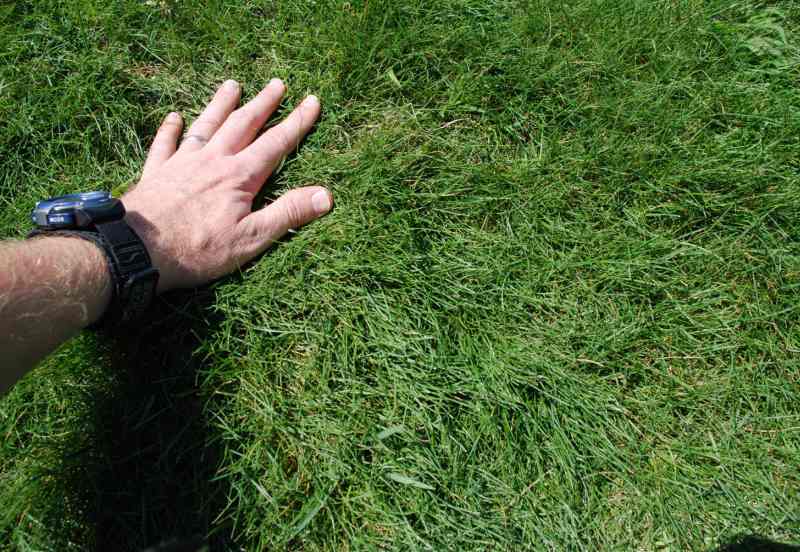
Aaron J. Patton, Ph.D. / Turfgrass Extension Specialist at Purdue University
If you have an area of your yard that is perpetually shaded and you’re constantly struggling to keep your lawn green, fine fescues might be the answer you’re looking for. These grasses are the most shade-tolerant, making them a great option for lawns partially shaded by trees or hardscapes.
In addition, while some grass varieties require a lot of watering to stay healthy, fine fescues are drought-resistant, meaning they can survive and thrive even in dry conditions. However, they are not ideal for high-traffic areas, but they may be what you need to create a peaceful, low-maintenance lawn.
With their fine texture and attractive appearance, they are sure to impress both you and your neighbors. They also blend well with other cool-season grasses such as Kentucky bluegrass, perennial ryegrass, and colonial bentgrass, for added shade tolerance.
Classification: Cool-season grass
Spreads by: Creeping red fescue spreads by rhizomes, while other fine fescues are bunch-type grasses, such as Chewings, hard, and sheep fescues.
Shade tolerance: Moderate to High, depending on species
Drought tolerance: Moderate to High, depending on species
Foot traffic tolerance: Low to Moderate, depending on species
Maintenance needs: Low fertilizer and mowing needs
Mowing height: Set mowing height between 2.5 and 4 inches, depending on species.
Potential for disease: Moderate. Common diseases include red thread, leaf spot, dollar spot, summer patch, and powdery mildew.
Soil pH: 6-6.5
Soil type: Will not perform well in wet soil conditions. Prefers drier soils and tolerates a wide range of soil types and fertility.
Other notes: Fine fescue varieties include chewings fescue, sheep fescue, hard fescue, and creeping red fescue.
Grass Seed Options:
– Outsidepride Legacy Fine Fescue Grass Seed (5 lbs.)
– Eretz Creeping Red Fine Fescue Seed (choose your size)
– Outsidepride Creeping Red Fine Fescue Grass Seed (25 lbs.)
– Outsidepride Hard Fine Fescue Grass Seed (10 lbs.)
Perennial Ryegrass
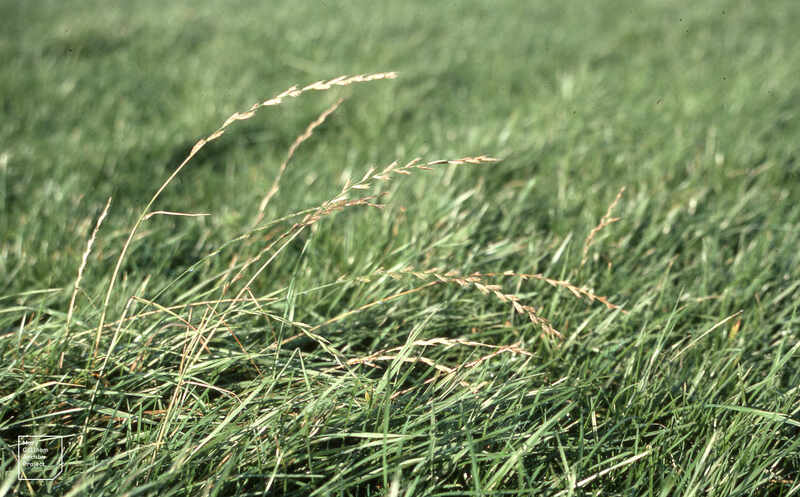
Photo Credit: Dr Mary Gillham Archive Project / Flickr / CC BY 2.0
Perennial ryegrass is another turfgrass option that is commonly used in the PNW. While it can be planted alone, it is often used in seed mixtures along with other grasses like fine fescues or Kentucky bluegrass to create a more diverse, resilient lawn.
Perennial ryegrass has a fast germination rate, which makes it an excellent choice for providing quick cover for other grasses while they grow at a slower pace. However, it’s worth noting that perennial ryegrass is not cold hardy and may struggle in regions with cold winters. Additionally, it does not tolerate shade or drought conditions well.
Classification: Cool-season grass
Spreads by: Has a bunch-type growth habit
Shade tolerance: Low
Drought tolerance: Low
Foot traffic tolerance: High
Maintenance needs: Moderate mowing and fertilization requirements. Thatch is not significant.
Mowing height: Set mowing height to 1.5 to 2.5 inches
Potential for disease: High. Common diseases include gray leaf spot, red thread, and leaf spot/melting-out.
Soil pH: Can grow in soils with a pH between 5 and 8, but prefers between 6 and 7.
Soil type: Prefers good drainage and fertility, but can tolerate some poor drainage.
Other notes: Although it’s not common to plant this grass seed alone (except in western Washington), if you decide to do it, you may need to overseed it periodically to maintain its thickness and to repair bare spots.
Grass Seed Options:
– Outsidepride Perennial Ryegrass Seed (5 lbs.)
– Eretz ProTurf Perennial Ryegrass Fine Lawn Seed (choose your size)
Colonial Bentgrass
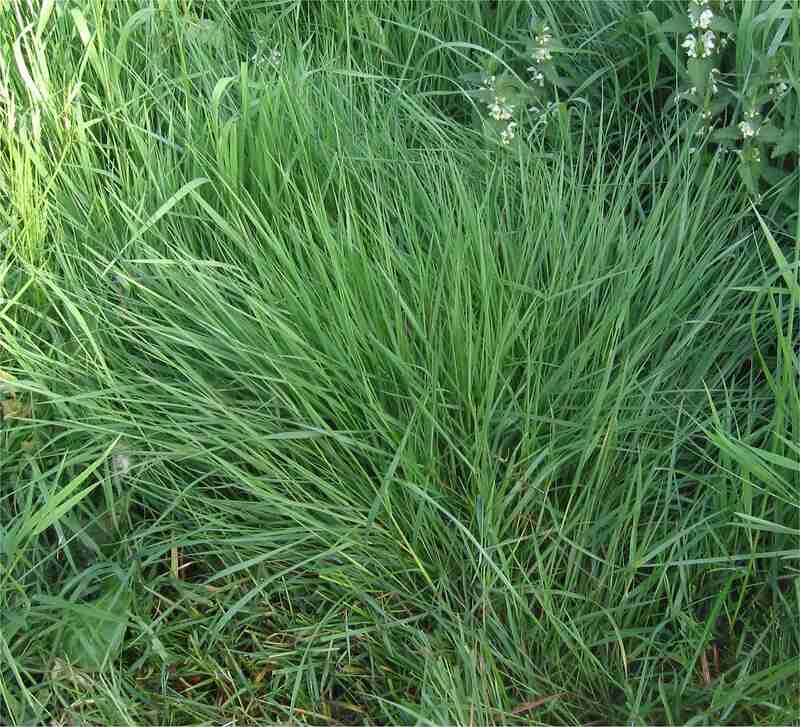
Colonial bentgrass is a grass seed option commonly used in the western region of Washington and Oregon. While it can be seeded alone, it is often added to seed blends containing fine fescues. This helps create a more resilient lawn that can withstand various environmental conditions.
However, it’s worth noting that colonial bentgrass is not a low-maintenance option for lawns in the Pacific Northwest. This grass must be mowed short, at least once a week, to below 0.75 inches to maintain its attractive appearance. Additionally, colonial bentgrass is not drought-resistant and may require additional watering during dry spells to stay healthy.
During winter, colonial bentgrass is also susceptible to snow mold — a fungal disease that can damage the grass and leave unsightly patches on the lawn.
Classification: Cool-season grass
Spreads by: Short rhizomes that may bring about short stolons
Shade tolerance: Moderate
Drought tolerance: Low
Traffic tolerance: Low
Maintenance needs: Moderate to high. Best when mowed short, at least once weekly.
Recommended mowing height: Set the mowing height between 0.5 and 1 inch.
Potential for Disease: Moderate. Susceptible to Fusarium patch in the winter. Vulnerable to Take-all patch when young but severity decreases as turf develops.
Soil pH: 5.5-6.5
Soil type: Tolerates poor soil conditions, but prefers moist and fertile soil.
Other Notes: Take into account that colonial bentgrass might take over other grass types when used in seed mixes.
Warm-Season Grass
Buffalograss
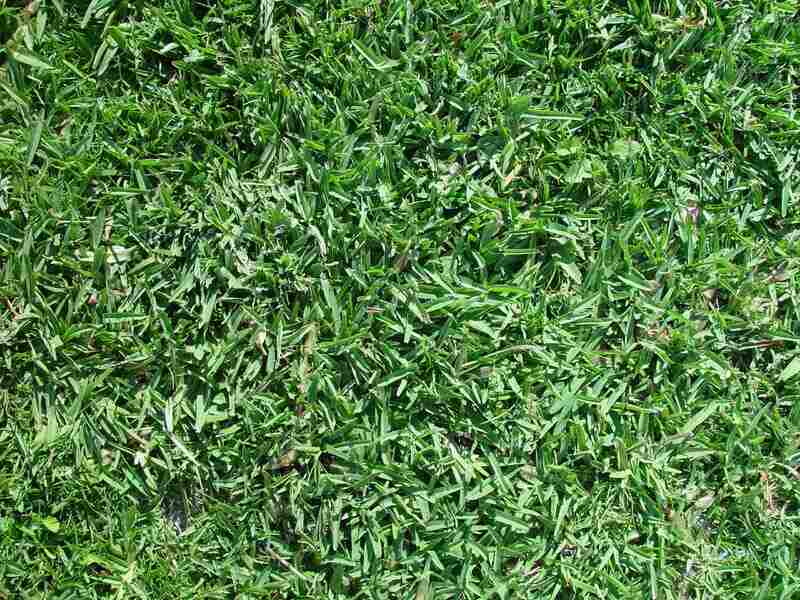
Photo Credit: Pixnio
Buffalograss is the only warm-season grass adapted to the Pacific Northwest, making it a unique grass seed option for those looking for something different for their lawn. While it is not commonly used throughout the region, it has gained popularity in parts of Idaho, where it is well-suited to the local climate and growing conditions.
This grass can withstand cold temperatures better than other grasses in its category, making it a great option for regions that experience chilly winters. Additionally, buffalograss is drought-resistant, low-maintenance, and doesn’t require much mowing since it grows slowly.
However, buffalograss does not tolerate shady areas well and may struggle in areas with high foot traffic. This makes it a better option for those looking to create a primarily ornamental lawn rather than a functional one.
Classification: Warm-season grass
Spreads by: Stolons
Shade tolerance: Low
Drought tolerance: High
Foot traffic tolerance: Low
Maintenance needs: Low fertilizer and mowing needs. Requires weed control.
Mowing height: Set the mowing height between 2 and 3 inches.
Potential for disease: Good tolerance against diseases and insects
Soil pH: 6.5-7.5
Soil type: Native clay soils, not sandy soils
Other notes: You’ll need to water new seedlings frequently until they’re established, as they’re only drought-resistant once matured.
Grass Seed Options:
– Everwilde Farms Buffalograss Seeds (1 lb. of seeds)
– Buffalograss seed (primed) (5-lb. bag)
What is the Best Grass Seed for Washington?
The best grass seed for Washington State can vary depending on a number of factors, including the local climate, soil type, and growing conditions. That being said, most cool-season grasses are well-adapted to the state’s climate and can provide a lush, green lawn with proper care and maintenance.
Washington state is divided into two distinct regions with different climates: western Washington, with its wetter, milder climate, and eastern Washington, which has a semi-arid climate with less rainfall but considerable snowfall.
For those living in western Washington, some of the best grass seed options include perennial ryegrass, fine fescues, tall fescue, and colonial bentgrass.
If you’re living in eastern Washington, some of the best grass seed options include Kentucky bluegrass, fine fescues, and tall fescue.
What is the Best Grass Seed for Oregon?
When it comes to choosing the best grass seed for Oregon, cool-season grasses are often the top choice. These grasses are well-adapted to the state’s cool, moist climate and are able to provide a beautiful, lush lawn with proper care and maintenance. They include:
- Perennial ryegrass
- Tall fescue
- Fine fescues
- Colonial bentgrass
If you live in eastern Oregon, consider planting Kentucky bluegrass. This grass is more cold-hardy than other varieties and is better able to withstand the region’s harsh winters.
What is the Best Grass Seed for Idaho?
The best grass seeds for Idaho also include cool-season grasses, such as Kentucky bluegrass, tall fescue, fine fescues, and perennial ryegrass.
However, it’s worth noting that buffalograss, a warm-season grass, can also be an excellent option for those looking to create a beautiful, low-maintenance lawn in Idaho. Buffalograss is well-adapted to the region’s hot, dry summers and can easily withstand cold temperatures and drought conditions.
How to Choose the Best Grass Seed for the Pacific Northwest
While understanding which grasses are best suited for the Pacific Northwest is helpful, this region encompasses multiple states with a wide range of climates and soil conditions. So, it’s also important to consider some other factors:
Maintenance Needs
The grass seed you choose should be based on your preferences and the time and effort you are willing to commit to maintaining your lawn. If you don’t have much time to dedicate to your lawn, consider choosing low-maintenance options.
High-maintenance grasses: Kentucky bluegrass
Moderate-maintenance grasses: Perennial ryegrass, tall fescue, colonial bentgrass
Low-maintenance grasses: Fine fescues, buffalograss
Shade Tolerance
Different grass types have varying degrees of shade tolerance, so it’s essential to choose a seed best suited to your yard’s specific conditions. This means selecting a grass variety that can thrive in partial shade or choosing one that requires full sun, depending on the number of structures casting shadows on your lawn.
High shade tolerance: Fine fescues
Moderate shade tolerance: Tall fescue, colonial bentgrass
Low shade tolerance: Kentucky bluegrass, perennial ryegrass, buffalograss
Drought Tolerance
Drought tolerance is a key factor to consider, particularly in drier regions of the Pacific Northwest, such as east of the Cascade Mountains, where rainfall is more limited.
High drought tolerance: Fine fescue, buffalograss
Moderate drought tolerance: Kentucky bluegrass, tall fescue
Low drought tolerance: Perennial ryegrass, colonial bentgrass
Wear Tolerance
When creating a wear-tolerant lawn, choosing a durable grass seed is key. This is especially important for families with children and pets who love to run and play in the yard. However, if your lawn is purely for aesthetic purposes, then a high foot-traffic tolerance may not be a concern.
High traffic tolerance: Perennial ryegrass
Moderate traffic tolerance: Kentucky bluegrass, tall fescue, colonial bentgrass
Low traffic tolerance: Fine fescues, buffalograss
Bring in the Pros
Still not sure which grass seed to choose for your new lawn? Why not enlist the help of a lawn care pro near you? We have trusted professionals in major Pacific Northwest cities, such as Seattle, Portland, Boise, and many more.
Main Image Credit: Shutterstock
LawnStarter participates in the Amazon Services LLC Associates Program, an affiliate advertising program. LawnStarter may earn revenue from products promoted in this article.